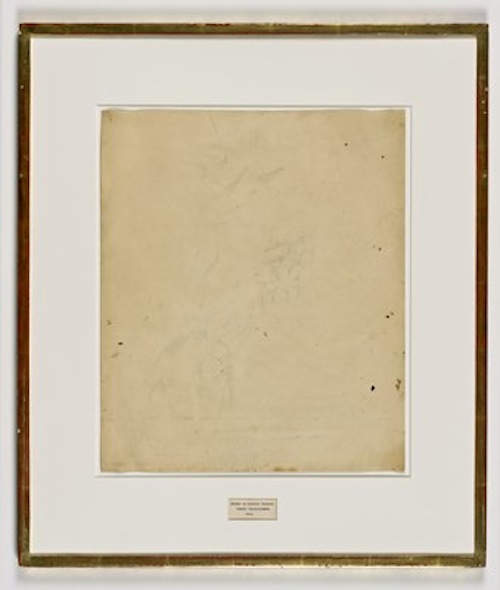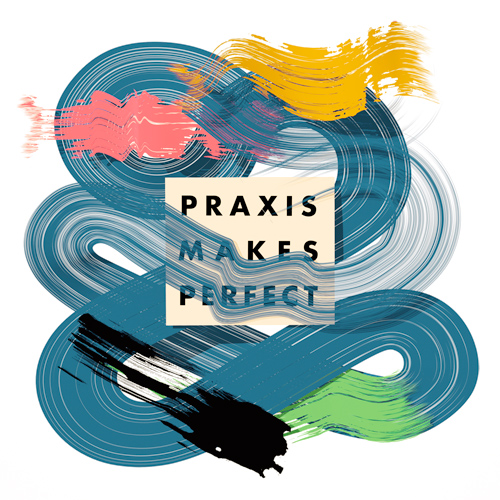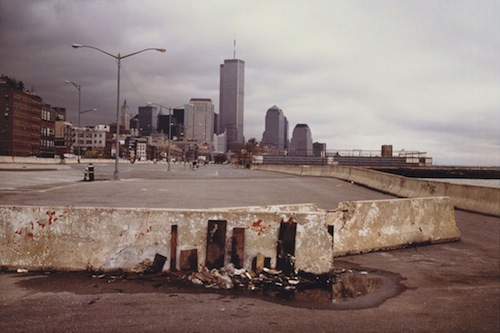In elementary school, I hated the process of erasing—the grubby flakes that rubbed off when you used the other end of the pencil, the telltale smudges on the page, and those terrible instances when you applied too much pressure and tore right through the paper. Lately, I’ve been pondering the act of erasing and its place in art making and interpretation. Perhaps the most notable example in art history is Robert Rauschenberg’s Erased de Kooning Drawing. For this, Rauschenberg famously obtained a unique drawing from Willem de Kooning and then spent a month painstakingly removing the imagery from the paper.

Robert Rauschenberg. “Erased de Kooning drawing,” 1953. Courtesy San Francisco Museum of Modern Art.
At first glance, Erased de Kooning Drawing is startling empty, calling into question the basic tenet that anything framed and hung on the wall of a museum is art. But as you look closer you will notice that the paper is not plain at all but in fact covered with traces of both artists—lingering marks from de Kooning’s original drawing, and the small tears, wrinkles, and smears made as Rauschenberg erased. Slowly, we begin to understand the enormity of the task Rauschenberg undertook. Slowly, we marvel at the precision and control he must have exercised to preserve the integrity of the paper. He has succeeded in making erasure itself an art.
Occasionally, I assist with Family Day programming at the Museum of Contemporary Art, Chicago, where I’ve noticed that many teaching artists incorporate erasing or deconstruction into their projects with the public. Surprisingly, disassembling the work of others is not a task easily embraced, even by an audience of children. I can’t be certain whether this is owed to inherent respect for the work of others or the standard rules of the art museum: Don’t Touch! But what I find most interesting is why artists feel the need to teach erasure and what audiences take away from the experience.
The best answer I can come up with is that erasing points directly to the messiness of process. Teaching artists want the public to understand that art making is difficult and time-consuming work that includes starts, stops, and changes; it’s not a straight path from a blank canvas to a framed masterpiece. This understanding makes it easier for visitors to appreciate art, and also prevents them from abandoning their own art projects when they don’t take the shape they had imagined.
Thinking about a work of art as the culmination of a messy process raises an important question: at what point does art happen? This is a question frequently raised in photography. Take, for example, Gabriel Orozco’s photograph Isla en la Isla (Island within an Island), showing a pre-9/11 New York City just before a storm. The streets are strangely deserted. In the foreground, a small “cityscape” made of refuse mirrors the skyline in the background. Does the art of this image live in the printed photograph when it’s on display in a gallery? Or did it occur when the artist angled the camera and framed the shot? Is the art in his ability to capture this moment of calm before the storm? What if the art belongs not to Orozco but to nature or the anonymous designer of the trashscape?
For me, the many possibilities for analysis and contemplation that an artwork presents are more important than the thing itself. Deconstructing a work of art requires, as with Erased de Kooning Drawing, careful consideration of the artist’s movements, methods, and choices. Learning to erase, then, means learning to embrace process in all of its messy glory—a lesson that extends well beyond the walls of the museum.





